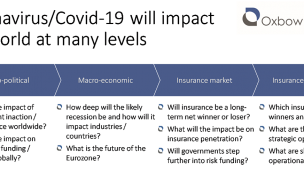Actionable metrics: Rethinking management information
25 May, 2016 Chris Sandilands
Do you manage a commercial insurance book as an underwriter or broker? Think about the last management report you saw.
It probably contained information about your income and costs, likely segmented by product or region. I’d guess there was also some information about staff turnover and maybe some charts and a few words of commentary. I bet that there were few, if any, metrics that genuinely allowed you to make strategic choices for your business. Let me explain.
We work in a modern office building in Moorgate. About fifty percent of the offices are occupied by ‘suits’ like us; the rest are full of hipsters building internet businesses. These offices share many common features: they are filled with young, mostly bearded, entrepreneurs, and there’s normally a giant monitor in the corner showing the business’s performance data.
These businesses are obsessed with understanding stats: marketing effectiveness, conversion rates, average basket sizes, etc.
This is in stark contrast to many insurers and brokers, where MI is often generated from finance systems. This means that MI is not only late, but also distorted by accounting adjustments and not segmented by strategic segments.
As a result, management don’t gain actionable insight into the business. For example, I’ve rarely seen monthly MI reports at a commercial insurer that break down volumes into its actionable drivers: structural losses, conversion rate on accessible renewal volume, renewal volume changes driven by rate increases vs. account retention vs. other factors.
To some extent insurers and brokers aren’t to blame. As my Partner Greg Brown explains in his excellent paper on policy admin systems, many of the legacy systems used by the industry simply don’t capture performance data, or, if they do, can’t produce reports on it.
But that is only a limited excuse. Our observation is that, irrespective of IT challenges, management teams should place much more emphasis on ‘actionable metrics’ in their management information.
Revenue is not an actionable metric – it is a single measure of the effectiveness of a huge number of interconnected activities. A fact-driven manager can infer almost nothing about the quality of the underlying business from revenue alone.
Others have been even harsher about revenue-based metrics. Eric Ries, in his best-selling book, The Lean Startup, describes metrics which have the potential to make you feel good but don’t give you any actionable insight as “vanity metrics”.
That’s harsh but true. We think insurers and brokers should rethink their management information and make sure they are managing the drivers of value in their business, not just polishing the outcomes.



